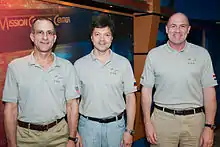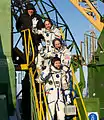Soyuz TMA-03M
Soyuz TMA-03M was a spaceflight to the International Space Station (ISS). It launched on 21 December 2011 from Site One at the Baikonur Cosmodrome, Kazakhstan, carrying three members of Expedition 30 to the ISS. TMA-03M was the 112th flight of a Russian Soyuz spacecraft, since the first in 1967, and the third flight of the modernised Soyuz-TMA-M version. The docking with the International Space Station took place at 19:19 Moscow Time on 23 December, three minutes ahead of schedule.[5][6]
 TMA-03M rollout in Baikonur | |
| Operator | Roskosmos |
|---|---|
| COSPAR ID | 2011-078A |
| SATCAT no. | 38036 |
| Spacecraft properties | |
| Spacecraft type | Soyuz-TMA 11F747 |
| Manufacturer | RKK Energia |
| Crew | |
| Crew size | 3 |
| Members | Oleg Kononenko André Kuipers Donald Pettit |
| Callsign | Antares |
| Start of mission | |
| Launch date | 21 December 2011, 13:16 UTC[1][2][3] |
| Rocket | Soyuz-FG |
| Launch site | Baikonur 1/5 |
| End of mission | |
| Landing date | 1 July 2012, 08:14 UTC |
| Landing site | 146 km SE of Dzhezkazgan, Kazakhstan 47°20′56.3″N 69°32′47.4″E[4] |
| Orbital parameters | |
| Reference system | Geocentric |
| Regime | Low Earth |
| Docking with ISS | |
| Docking port | Rassvet nadir |
| Docking date | 23 December 2011 15:19 UTC |
| Undocking date | 1 July 2012 04:47 UTC |
| Time docked | 190d 13h 28m |
 From left to right: Donald Pettit, Oleg Kononenko and André Kuipers Soyuz programme (Crewed missions) | |
The crew were Oleg Kononenko (Russia, commander), André Kuipers (the Netherlands) and Donald Pettit (United States). The Soyuz remained aboard the space station for the Expedition 30 increment to serve as an emergency escape vehicle if needed.
The capsule used in the mission can be seen at the Space Expo visitors center at the European Space Research and Technology Centre in Noordwijk, Netherlands.[7]
Crew
| Position[2][8] | Crew Member | |
|---|---|---|
| Commander | Expedition 30 Second spaceflight | |
| Flight Engineer 1 | Expedition 30 Second and last spaceflight | |
| Flight Engineer 2 | Expedition 30 Third spaceflight | |
Backup crew
| Position | Crew Member | |
|---|---|---|
| Commander | ||
| Flight Engineer 1 | ||
| Flight Engineer 2 | ||
Mission insignia
The Soyuz TMA-03M mission insignia (or 'patch') was designed by Luc van den Abeelen, partially based on artwork by 11-year-old Alena Gerasimova from Petrozavodsk, Russia.[9] Former Roscosmos head Anatoly Perminov officially approved the patch on 9 March 2011.[10] The Soyuz TMA-03M patch was the final patch based on the children's competition initiated for the Soyuz TMA-14 flight. The children's project had been organized by Roscosmos Public Relations and in mid-2011 the Gagarin Cosmonaut Training Center took over responsibility for the operational aspects of the Soyuz patches.
Mission details

The mission launched on 21 December 2011, at 17:16:15 Moscow time (13:16:15 GMT) using the Soyuz-FG rocket system. After a 528-second flight, Soyuz ТМА-03М successfully disconnected from the third stage on a satellite orbit.[6] Soyuz Commander Kononenko was launched from the Soyuz's center seat with flight engineer Donald Pettit strapped in to his right and ESA astronaut Andre Kuipers on his left.
The launch occurred a little more than an hour after sunset at Baikonur in bitterly cold weather with temperatures near -18 degrees Celsius (0 F).[11] Live television footage from inside the spacecraft's showed the crew members looking relaxed as they monitored the automated ascent. Shortly after the Soyuz slipped into a preliminary orbit, the Russian Mission Control said "Congratulations, guys, on a good insertion, (there are) no issues with telemetry or anything at all at this time, We wish you best of luck. You are experienced people, I'm sure everything is going to go very well".[11]
During the next two days after the launch, three major rendezvous burns were performed to put the spacecraft on a refined path to the ISS.
 Rolling out to launch pad.
Rolling out to launch pad. Soyuz TMA-03M spacecraft seen at the launch pad on 19 December 2011.
Soyuz TMA-03M spacecraft seen at the launch pad on 19 December 2011. Soyuz TMA-03M crew members wave farewell from the base of the rocket.
Soyuz TMA-03M crew members wave farewell from the base of the rocket. Soyuz TMA-03M lifts off from Baikonur on 21 December 2011.
Soyuz TMA-03M lifts off from Baikonur on 21 December 2011.
Docking
Following the two-day rendezvous, the Soyuz spacecraft successfully docked to the Mini Research Module-1 (MRM-1) "Rassvet" Nadir docking port at 15:19 GMT on 23 December 2011.[12] The port was vacated just over one month earlier by the Soyuz TMA-02M.
The entire process of approaching and docking with the ISS went nominally as planned. After arriving in the vicinity of the ISS, the spacecraft made a short flyaround maneuver to achieve a perfect alignment with the Docking Port on the Rassvet Module. The station keeping started at a distance of 200 meters to the docking target. This gave teams inside the Russian Mission Control adequate time to evaluate systems and alignment. The final GO for approach came after just a few minutes and Soyuz Commander Kononenko sent the command for the final phase of the docking operation. The docking occurred three minutes ahead of previously announced time of 19:22:41 Moscow Time when the Soyuz TMA-03M gently came into contact with the ISS at a relative velocity of less than 0.3 m/s.[13] At the time of docking, the two spacecraft were sailing 240 miles over southern Russia.[14]
Soft Docking was confirmed shortly thereafter and hooks and latches were closed 10 minutes after docking to form a hard-mate between space station and the Soyuz TMA-03M spacecraft. Extensive leak checks and vehicle reconfigurations were made from both sides of the docking system before Mission Control gave a GO to open the hatches between the Soyuz TMA-03M spacecraft and the ISS. Following the hatch opening, the crew members floated aboard the ISS to greet the already-aboard Dan Burbank, Anton Shkaplerov and Anatoli Ivanishin. Together, the two crews formed the full group of Expedition 30 until March 2012.
 Soyuz TMA-03M approaches the Rassvet module for docking.
Soyuz TMA-03M approaches the Rassvet module for docking. Soyuz TMA-03M docked to Rassvet and Progress M-13M docked to Pirs.
Soyuz TMA-03M docked to Rassvet and Progress M-13M docked to Pirs. Soyuz TMA-03M undocks from the Rassvet Mini-Research Module.
Soyuz TMA-03M undocks from the Rassvet Mini-Research Module.
Return to Earth
Soyuz TMA-03M undocked from the ISS on 1 July 2012 at 4:47 AM (GMT), carrying Pettit, Kononenko and Kuipers, and landed safely near Zhezkazgan, Kazakhstan, at 8:14 AM the same day.[15] The spacecraft's departure ended Expedition 31, and left astronauts Gennady Padalka, Sergei Revin and Joseph Acaba aboard the station to begin Expedition 32.
.jpg.webp) The Soyuz TMA-03M capsule descends past helicopter.
The Soyuz TMA-03M capsule descends past helicopter. The Soyuz TMA-03M spacecraft lands in central Kazakhstan.
The Soyuz TMA-03M spacecraft lands in central Kazakhstan. Russian Search and Rescue crews attach ladders and a slide for access to the capsule.
Russian Search and Rescue crews attach ladders and a slide for access to the capsule. The Soyuz crew is pictured shortly after landing.
The Soyuz crew is pictured shortly after landing. Support and medical personnel carry the crew to the medical tent.
Support and medical personnel carry the crew to the medical tent.
References
- NASA. "Consolidated Launch Manifest". NASA. Retrieved 6 June 2011.
- ESA astronaut André Kuipers to spend six months on the ISS starting in 2011
- "Russian Rocket Launches Astronauts on Holiday Space Station Trip". Space.com. 21 December 2011. Archived from the original on 12 June 2023.
- "Soyuz Landing Coordinates". NASA Spacflight Fourum. 2 July 2012. Retrieved 2 June 2018.
- "ESA astronaut André Kuipers arrives at the Space Station". European Space Agency. 23 December 2011. Retrieved 24 December 2011.
- Состоялся запуск транспортного пилотируемого корабля «Союз ТМА-03М» Archived 19 June 2013 at the Wayback Machine Roscosmos (in Russian)
- "Exposition - All about space". Space Expo. Retrieved 24 May 2019.
- NASA HQ (2009). "NASA and its International Partners Assign Space Station Crews". NASA. Retrieved 7 October 2009.
- Robert Pearlman (12 August 2011). "Soyuz TMA-03M mission patch". CollectSPACE.com. Retrieved 25 September 2011.
- Roscosmos (20 September 2011). "Утверждена эмблема экипажа «Союз ТМА-03М". Archived from the original on 2 April 2012. Retrieved 25 September 2011.
- William Harwood (21 December 2011). "Next trio launches on space station's 30th expedition". Spaceflight Now. Retrieved 25 December 2011.
- Pete Harding (23 December 2011). "Soyuz TMA-03M docks to ISS, returns station to six crew members for future ops". NASAspaceflight.com. Retrieved 25 December 2011.
- "Soyuz TMA-03M arrives at ISS". SPACEFLIGHT 101. 23 December 2011. Archived from the original on 26 April 2012. Retrieved 1 January 2012.
- Clara Moskowitz (23 December 2011). "Astronauts arrive at space station for the holidays: International space station 'back at full strength' with six crew members". Space on NBC News. Retrieved 25 December 2011.
- "Expedition 31 Crew Returns to Earth". NASA. 1 July 2012. Retrieved 11 July 2012.


